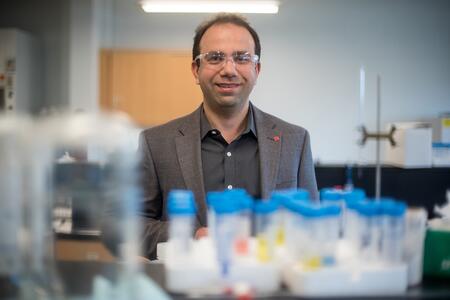Queen’s University researchers have gained recognition for the discoveries they have made in medicine, engineering, and the sciences; innovations that have improved the lives of people around the world. To make sure that the university and the public continue to benefit from this work, Queen’s Partnerships and Innovation (QPI) promotes the discoveries of university researchers who have assigned their intellectual property to Queen’s and whose work is ready for licensing and commercial application. QPI leads the commercialization processes, including the protection of the intellectual property, the creation of strategies to further its development, the search for funders, partners, and licensees, the negotiation of terms, the management of relationships, the collection of licensing and royalty revenues, and their disbursement to inventors.
Electric vehicles (EV) are the fastest-growing segment of the vehicle market today. Accounting for sales of more than 8 million vehicles in 2022, by 2030 EV sales are projected to exceed more than 39 million annually. For our car-based culture, they represent a plausible greener future, one where we may not need to radically alter our way of life.

Photo courtesy of Dr. Ghahreman.
While these vehicles are clean in terms of CO2 emissions, they are not without their own environmental challenges. This is particularly true regarding the lithium iron phosphorus battery which is becoming the standard source of energy for EVs. Known for short as LFP batteries (the F stands for iron), they are cheaper to produce than other lithium-ion batteries that use cobalt. In the coming years, experts say fifty percent of the EV market will be powered by LFPs.
Thanks to their chemical composition, LFP batteries are much cheaper to produce than other lithium-ion batteries, which will bring down the cost of EVs equipped with them. There’s a catch, however. In general, it is worth recycling many lithium-ion batteries – to extract the lithium and, where it’s used, the cobalt. These are expensive materials. Unfortunately, the cheaper materials used in manufacturing LFP batteries, specifically the iron and phosphorus, mean that at present it’s not worth trying to extract the lithium for reuse. In fact, it costs money to recycle them. Someday, we may well be driving everywhere in electric cars – while dumping thousands of defunct batteries – and the valuable lithium in them – into landfill sites.
Ahmad Ghahreman, a professor of mining cross-appointed with chemical engineering at Queen’s University, thinks he has discovered a way to extract just the lithium from the LFP batteries, using a chemical process. His technology anticipates a coming need; the question is how to get his process to market.
Dr. Ghahreman started working on this project in 2019. (He has made recycling for electric cars something of a specialty. He is currently on leave from Queen’s to develop a company called Cyclic Materials, which is developing methods for recycling the rare earth magnets found in the motors that power EVs).
“Early on in the lab, we thought we had something of value,” says Dr. Ghahreman. “To my knowledge, not many companies have a solution for recycling on the LFP side. We couldn’t find anything in the literature or the patents that used the same process, so I got in touch with Jason Hendry [Partnerships Development Officer at Queen’s Partnerships and Innovation (QPI)].”
Working with Hendry and the patent team at QPI, they filed an international patent application in late 2020.
“It’s under review right now,” says Dr. Ghahreman, “and I think in the next year we should know about that.”
Hendry also worked with Dr. Ghahreman to secure an Idea to Innovation grant through NSERC, funding which is intended to develop new technologies at Canadian universities and promote their transfer to new or existing Canadian companies. This money currently underwrites three students at Queen’s who are working on this technology.
“We want to develop the process at a larger scale and conduct it from end to end. To confirm, that it is in fact economically viable,” says Hendry. That means processing actual batteries and extracting the lithium, as opposed to working with what is commonly referred to as “black mass” – material composed of crushed and shredded battery cell material.
So, a good idea. But, says Hendry, “the university can only take it so far.” After they have completed their current work, they will be back to NSERC once more, to apply for a phase II, I2I grant, which will provide them funding to determine their invention’s, “technical feasibility and market.” A key part of this stage is to find a partner wiling to underwrite up to half their expenses.
For that, says Dr. Ghahreman, they face two options. “One might be to find an entrepreneur interested in creating a firm around the technology and taking it to the next step that way.”
This is a new technology, although a promising one, and whether such an individual can be found “all depends on the level of risk that your partner is willing to take on,” says Hendry.
The other possibility, says Ghahreman, “is to submit the technology to one of the premium lithium recyclers, and we do know quite few of them in North America and the rest of the world.” They would take it and then run with it. Often, says Hendry, “If you approach,” he names a major battery recycling company,” and say I’ve got a new process, they’re going to say we’ve already told our investor that our product is the best.” In this case, however, what they can offer is not a competing process, but a new one.
Selling “the LFP recycling process is a little bit easier,” says Hendry, “because these companies don’t have a process for LFP batteries – or not a good one. As they look to expand in the changing battery market, for them this will make economic sense.”
Readers interested in licensing or learning more, about the technology Dr. Ghahreman has developed, should visit Queens's technology information page and contact Jason Hendry at jason.hendry@queensu.ca.
 About Vice-Principal Research
About Vice-Principal Research